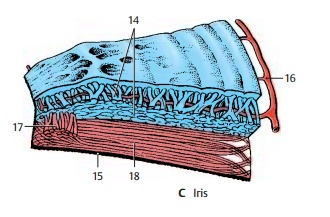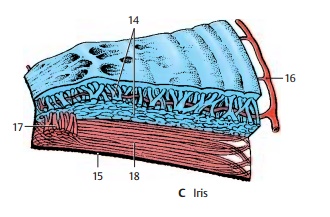Chapter: Human Nervous System and Sensory Organs : The Eye
Iris - Structure of the Eye

Iris
The iris (A11) forms an aperture in front of the lens. It is attached to the ciliary body at the root of the iris (A12) and extends to the pupillary margin (A13). The iris consists oftwo layers, namely, the mesodermal stroma (AC14) and the ectodermal posterior aspect of the iris, known as the iridial part of theretina (AC15). The stroma is made up of con-nective-tissue strands and is pigmented. A high pigment content results in brown eyes, while a low pigment content gives the eyes a green or blue appearance. Numerousblood vessels branch radially off the greaterarterial circle of the iris (AC16). The ectoder-mal part of the iris, a derivative of the optic cup, gives rise to two smooth muscles, namely, the sphincter muscle of thepupil (AC17) and the thin dilator muscle of the pupil (AC18).


Related Topics